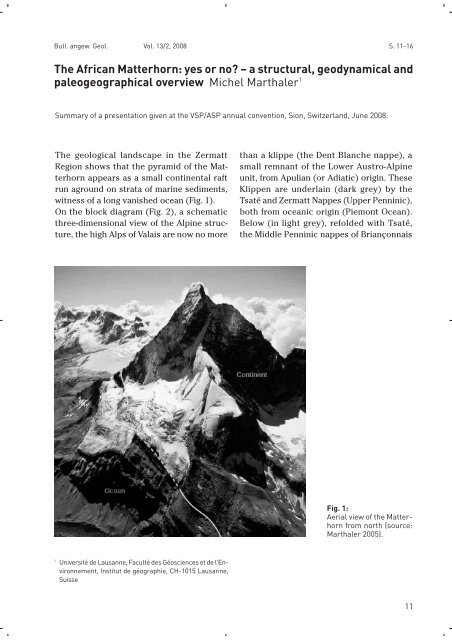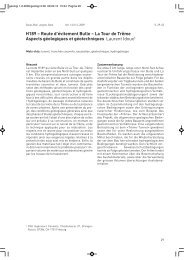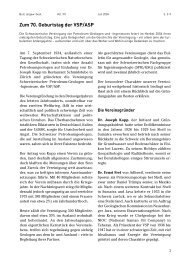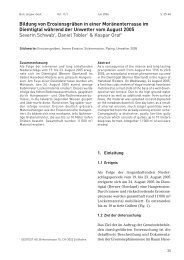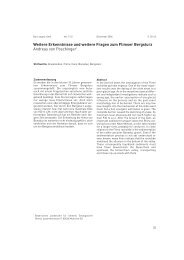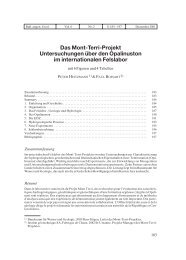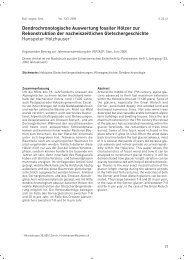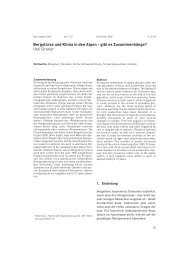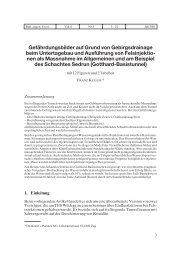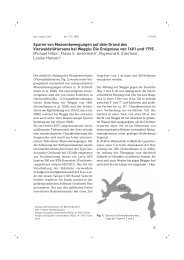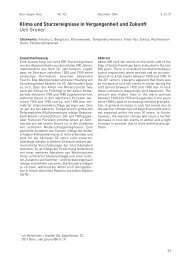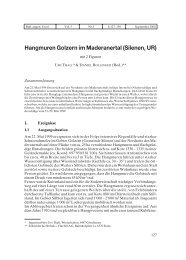The African Matterhorn: yes or no?
The African Matterhorn: yes or no?
The African Matterhorn: yes or no?
Create successful ePaper yourself
Turn your PDF publications into a flip-book with our unique Google optimized e-Paper software.
Bull. angew. Geol. Vol. 13/2, 2008 S. 11-16<br />
<strong>The</strong> <strong>African</strong> <strong>Matterh<strong>or</strong>n</strong>: <strong>yes</strong> <strong>or</strong> <strong>no</strong>? – a structural, geodynamical and<br />
paleogeographical overview Michel Marthaler 1<br />
Summary of a presentation given at the VSP/ASP annual convention, Sion, Switzerland, June 2008.<br />
<strong>The</strong> geological landscape in the Zermatt<br />
Region shows that the pyramid of the <strong>Matterh<strong>or</strong>n</strong><br />
appears as a small continental raft<br />
run aground on strata of marine sediments,<br />
witness of a long vanished ocean (Fig. 1).<br />
On the block diagram (Fig. 2), a schematic<br />
three-dimensional view of the Alpine structure,<br />
the high Alps of Valais are <strong>no</strong>w <strong>no</strong> m<strong>or</strong>e<br />
than a klippe (the Dent Blanche nappe), a<br />
small remnant of the Lower Austro-Alpine<br />
unit, from Apulian (<strong>or</strong> Adiatic) <strong>or</strong>igin. <strong>The</strong>se<br />
Klippen are underlain (dark grey) by the<br />
Tsaté and Zermatt Nappes (Upper Penninic),<br />
both from oceanic <strong>or</strong>igin (Piemont Ocean).<br />
Below (in light grey), refolded with Tsaté,<br />
the Middle Penninic nappes of Briançonnais<br />
Fig. 1:<br />
Aerial view of the <strong>Matterh<strong>or</strong>n</strong><br />
from n<strong>or</strong>th (source:<br />
Marthaler 2005).<br />
1<br />
Université de Lausanne, Faculté des Géosciences et de l’Environnement,<br />
Institut de géographie, CH-1015 Lausanne,<br />
Suisse<br />
11
<strong>or</strong>igin, representing a mostly shallower<br />
marine environment underlain by continental<br />
crust.<br />
This superposition is beautifully visible<br />
from the G<strong>or</strong>nergrat (Fig. 3, 4). Stucturally<br />
from base to the top: <strong>The</strong> basement rocks of<br />
Briançonnais <strong>or</strong>igin (continental lower<br />
plate, here the Monte Rosa and Lyskamm)<br />
are dipping west under a sequence of serpentinite<br />
and ophiolite, representing the<br />
oceanic crust (here Breith<strong>or</strong>n and Little <strong>Matterh<strong>or</strong>n</strong>).<br />
M<strong>or</strong>e in the western direction, the<br />
Dent Blanche nappe (klippe of continental<br />
upper plate) f<strong>or</strong>ms the high peaks of the<br />
Valaisan Alps, from the <strong>Matterh<strong>or</strong>n</strong> to the<br />
Weissh<strong>or</strong>n.<br />
<strong>The</strong> cross-section from SE to NW (Escher et<br />
al. 1997) in Fig. 5 shows the three main units<br />
in greater details.<br />
<strong>The</strong> hist<strong>or</strong>y of the alpine <strong>or</strong>ogenic cycle is<br />
related to the evolution of the Tethys and its<br />
later def<strong>or</strong>mation by the closing-in of Africa<br />
against Europe. <strong>The</strong> Tethys oceanisation<br />
started at early Jurassic times (Fig. 6A).<br />
Between Europe and N<strong>or</strong>thern Africa (Apu-<br />
Fig. 2: In this simplified block diagram, adapted from Burri (1992), back folds have <strong>no</strong>t been drawn. Note<br />
the longitudinal curvature of the f<strong>or</strong>ward folds, giving rise to the preservation of sediments of the<br />
Helvetic nappes in the Valaisan depression, whereas in the massifs of Mont Blanc and Aar updoming<br />
continental crust is exposed at surface. <strong>The</strong> strongly uplifted Tici<strong>no</strong> dome has laid bare the<br />
European bedrock. <strong>The</strong> overlying pile of Penninic and Austro-alpine nappes have been entirely<br />
eroded away. <strong>The</strong>se nappes are still conserved in the Eastern Alps (Austria and the Engadine Valley)<br />
and in central parts of the Valais. <strong>The</strong> high Alps of the Canton Valais are representing a Klippe<br />
(k<strong>no</strong>wn as the Dent Blanche nappe, out of which the <strong>Matterh<strong>or</strong>n</strong> itself is carved), a small remnant<br />
of an Austro-alpine unit from the n<strong>or</strong>thern edge of the Apulian plate, that was once much larger<br />
than it is at present. [1] Austro-alpine nappes, [2] upper Penninic nappes, [3] middle Penninic<br />
nappes, [4] metasedimentary, lower Penninic nappes, [5] Helvetic nappes, [6] external crystalline<br />
massif and lower Penninic nappes; Simplon fault (dotted line).<br />
12
lia), the Piemont Ocean is opening thanks to<br />
the spreading of a very active mid-oceanic<br />
ridge. In Zermatt we can observe pillow lava,<br />
nicely demonstrating the oceanic nature of<br />
this crust.<strong>The</strong> Jurassic pillow shape is well<br />
preserved in spite of an overprint by an early<br />
Tertiary metam<strong>or</strong>phism.<br />
During Cretaceous times, the tectonic<br />
regime changed from the opening of the<br />
Tethys to a progressive closing, initiating<br />
the Alpine <strong>or</strong>ogenic event (Fig. 6B). <strong>The</strong><br />
southern margin is becoming active, with<br />
oceanic subduction under Apulia. An accretionary<br />
prism is building, witness of the vanished<br />
ocean (today the Tsaté and Zermatt<br />
nappes). <strong>The</strong> separation of the Briançonnais<br />
from the European continent lasted until<br />
early Tertiary when, with the continuous<br />
sh<strong>or</strong>tening of the n<strong>or</strong>thern Valaisan Trough,<br />
the subduction became continental, as testified<br />
by the high pressure metam<strong>or</strong>phism of<br />
part of the Briançonnais (the Monte Rosa in<br />
particular). <strong>The</strong> landscape of the Moiry<br />
region (Fig. 7) illustrates this development<br />
in a masterly way.<br />
<strong>The</strong> emplacement of the <strong>Matterh<strong>or</strong>n</strong> Klippe,<br />
representing Apulian/<strong>African</strong> continental<br />
crust, on the underlying oceanic crust of the<br />
Piemont Trough, occurred during late<br />
Oligocene.<br />
<strong>The</strong> <strong>African</strong> <strong>Matterh<strong>or</strong>n</strong>: <strong>yes</strong> <strong>or</strong> <strong>no</strong>? – <strong>The</strong><br />
answer is double: Yes f<strong>or</strong> the rocks, <strong>no</strong> f<strong>or</strong><br />
the shape. <strong>The</strong> cause of this change is the<br />
plate tectonic hist<strong>or</strong>y of the Alps.<br />
Fig. 3: Pan<strong>or</strong>ama from the G<strong>or</strong>nergrat, drawn by M. Sart<strong>or</strong>i, Departement of Geology and Paleontology,<br />
University of Geneva. A view on two continents and the remains of a vanished ocean. [1] Briançonnais<br />
basement: granites, gneisses (Protero-Paleozoic); [2] Oceanic metasediments: mainly calcareous<br />
schists (Jurassic-Cretaceous); [3] Oceanic crust (ophiolite): metabasalts, metagabbros,<br />
serpentinites (Jurassic). Tectonic setting: [1] Monte Rosa nappe, [2/3] Zermatt - Saas Fee Zone.<br />
13
Fig. 4: Pan<strong>or</strong>ama from the G<strong>or</strong>nergrat, continued from Fig. 3. [1] Austro-alpine basement: granitic gneisses,<br />
gneisses and metagabbros (Paleozoic); [2] Oceanic metasediments: mainly calcareous schists<br />
(«Schistes lustrés») (Jurassic-Cretaceous); [3] Scraps of oceanic crust: metabasalts, metagabbros<br />
(Jurassic); [4] Sediments from the Briançonnais platf<strong>or</strong>m: quartzites, dolomites, marbles (Permian<br />
to Tertiary); [5] Briançonnais basement: granites, gneisses (Protero-Paleozoic). Tectonic setting:<br />
[1] Dent-Blanche nappe, [2/3] Tsaté nappe <strong>or</strong> Combin Zone, [4/5] Siviez-Mischabel nappe.<br />
Fig. 5: Simplified geological cross-section showing the relation between the Monte-Rosa, Siviez-Mischabel,<br />
Zermatt-Saas Fee, Tsaté and Dent Blanche nappes in the Zermatt region (Escher et al. 1997).<br />
14
Fig. 6: (A) Cross-section through the Piemont Ocean at mid Jurassic: Tethys oceanisation started at early<br />
Jurassic times. Between Europe and N<strong>or</strong>thern Africa (Apulia), the Piemont Ocean is opening due to<br />
spreading along its mid-oceanic ridge. (B) Cross-section at mid Cretaceous: Opening of the<br />
Valaisan Ocean and subduction of the Piemont oceanic crust underneath the apulian plate. While<br />
subduction continues, oceanic crust is planed off, giving rise to the f<strong>or</strong>mation of the accretionary<br />
prism. (C) Mid-cretaceous paleogeography showing the position of sections A and B. Figure adapted<br />
from Stampfli 1993, 1998.<br />
15
Fig. 7: <strong>The</strong> continent-ocean-continent superposition: a fundamental feature of high-Alpine landscapes in<br />
Canton Valais. Same superposition as shown in Fig. 4, but from NW. [1] Paleozoic gneisses of the<br />
Apulian continental crust (Dent Blanche nappe); [2a] Cretaceous schists: Piemont oceanic<br />
metasediments (Tsaté nappe); [2b] Jurassic ophiolites, scrapped oceanic crust (Tsaté nappe); [3a]<br />
Paleozoic gneisses, micaschists and amphibolites of the Briançonnais continental margin (Siviez-<br />
Mischabel nappe); [3b] Permo-triassic quartzites: continental sediments of the Briançonnais margin.<br />
Tectonic setting: [1] Apulia, old african continent, [2] remnants of a vanished ocean, accretionary<br />
prism, [3] Iberia, European continent. Pan<strong>or</strong>ama drawn by M. Sart<strong>or</strong>i, Departement of Geology<br />
and Paleontology, University of Geneva.<br />
References<br />
Burri, M. 1992: Die Gesteine. Erkenne die Natur im<br />
Wallis. Pillet, St. Maurice.<br />
Escher, A., Masson, H. Steck, A., Epard, J.-L.,<br />
Marchant, R., Marthaler, M., Sart<strong>or</strong>i, M. & Venturini,<br />
G. 1997: Geologic framew<strong>or</strong>k and structural<br />
evolution of the Western Swiss-Italian Alps.<br />
In: Deep structure of the Alps – Results from<br />
NFP 20. Birkhäuser Verlag, Basel. 205-222.<br />
Marthaler, M. 2005: <strong>The</strong> Alps and our Planet. <strong>The</strong><br />
<strong>African</strong> <strong>Matterh<strong>or</strong>n</strong>: a Geological St<strong>or</strong>y. Editions<br />
LEP, Le Mont sur Lausanne.<br />
Stampfli, G.-M. 1993: Le Briançonnais, terrain exotique<br />
dans les Alpes? Eclogae geol. Helv. 86/1, 1-<br />
45.<br />
Stampfli, G.-M., Mosar, J., Marchant, R., Marquer,<br />
D., Baudin, T. & B<strong>or</strong>el, G. 1998: Subduction and<br />
obduction processes in the Western Alps.<br />
Tecto<strong>no</strong>physics, 296, 159-204.<br />
16


